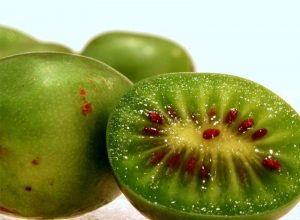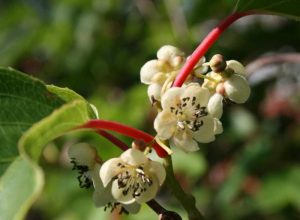Mini Kiwi – Actinidia Arguta


Introduced in Italy little more than forty years ago, the Actiidia Chinensis, better known with the common name of Kiwi, rapidly reached success both with the consumers, and the farmers, making our Country the biggest producers of Kiwi in the world.
The Actinidia arguta (Mini Kiwi), still not very known compared to the popular Chinensis (see kiwi), it can certainly be considered as a very particular fruit.
Like the Kiwi, it has the same origin and also the characteristics are very similar.
This is also a vine, but with a more contained vegetation and it’s posture recalls a messy shrub, its branches can grow to 3/4 metres and the leaves are lanceolate and very small. More resistant to the wintery cold and, having a less herbaceous vegetation, it’s also more resistant to late frosts and to wind, like all fruit plants, it requires a sunny exposure.
TERRAIN
Like all berries, Vaccinium myrtillus, even the pink berry needs acid soils, in those that are neutral or basic, with ph at 7 or above, ferric chlorosis would arise that would kill the plant in a few months. They need to be very fresh and organic soils, rich in humus, well drained and without water stagnation.
FLORA AND FRUIT
If in the Kiwi (see Kiwi) the variety universally recognised as the best and almost exclusively cultivated is the Hayward and, for a few years, the Soreli, in the mini kiwi the varieties that are appreciated are different also with different features between them. They are all plants with only male or female flowers, quite small, maximum two centimetres, with white to cream white colour.
The very small fruit is something in common between the varieties of Actinidia arguta, with a very thin skin, edible, without fluff and that can be eaten like a big cherry and, compared to the bigger Kiwi, with superior organoleptic qualities. Unlike the Kiwi, the fruit of the Mini Kiwi are not climacteric (see feijoa sellowiana) therefore they have a limited period for storing.
USE AND HEALTH PROPERTIES
It’s very hard to find the small and very tasty fruit of the Mini Kiwi at the greengrocers, the lucky owners of the plant can taste the fruit they just picked in succulent fruit salads or as a garnish for pies. It can’t be frozen.
Like the bigger Kiwi, it’s rich in vitamin C and it contains potassium and vitamin A. Inositol is also present (vitamin B7) that gives laxative properties, increasing the intestines motility and reducing cholesterol absorption.
PRUNING AND CULTIVATION
During the dead season it’s best to thin the older branches and shorten the remaining; during the summer the pollens will be cut and some of the branches without fruit, leaving some for the plant’s renewal.
As there aren’t important cultivations of actinidia Arguta that can facilitate the development of parasites and fungi attacks, the Mini Kiwi isn’t particularly affected by specific pathologies: anyway cochineal and grey mould (Botrytis) can attack the plant. At the moment, attacks from PSA (Pseudomonas syringae actinidiae) are not known to plants of Actinidia Arguta.
